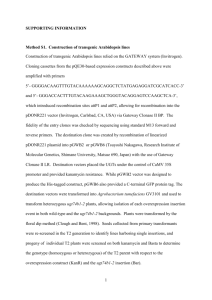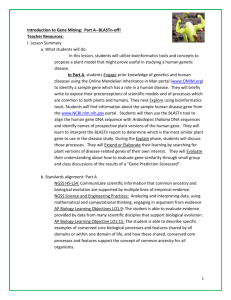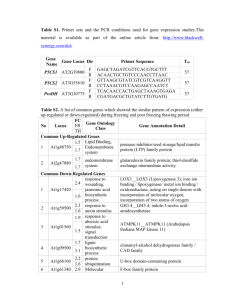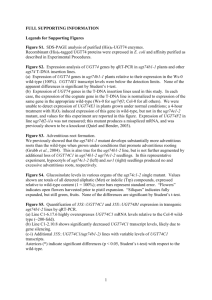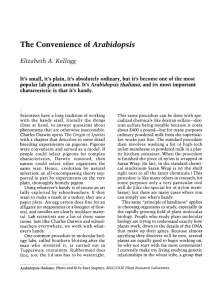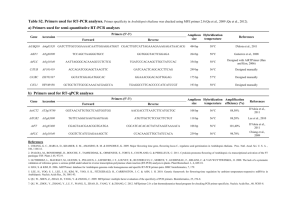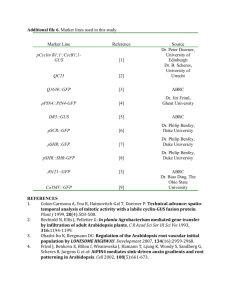Teacher Resources
advertisement
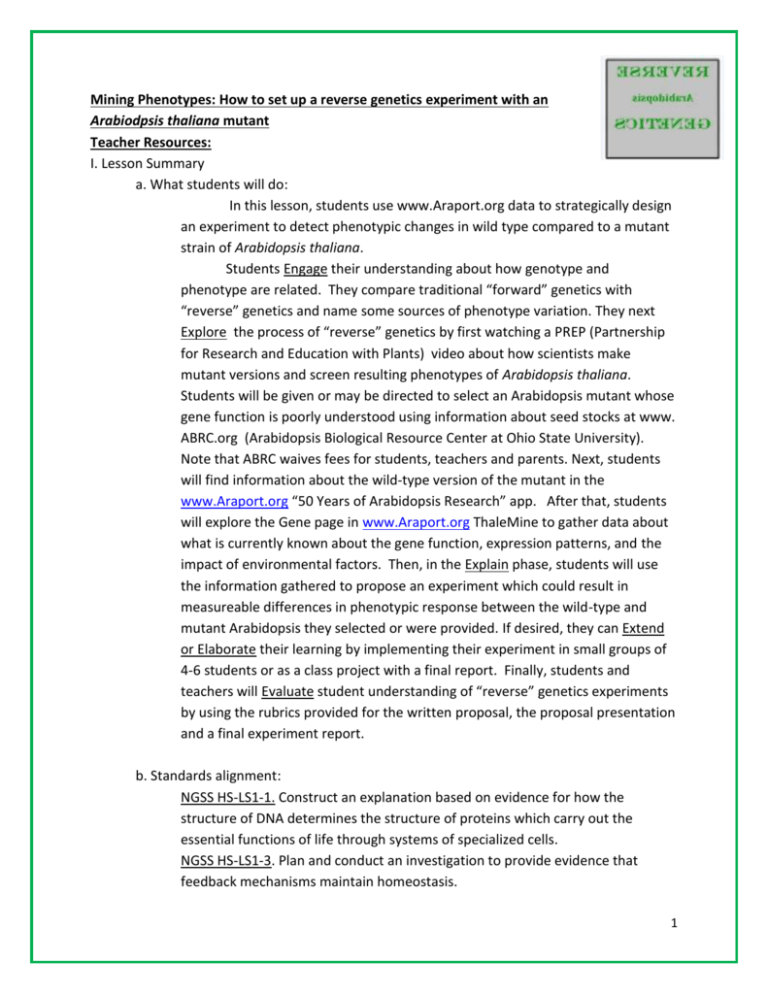
Mining Phenotypes: How to set up a reverse genetics experiment with an Arabiodpsis thaliana mutant Teacher Resources: I. Lesson Summary a. What students will do: In this lesson, students use www.Araport.org data to strategically design an experiment to detect phenotypic changes in wild type compared to a mutant strain of Arabidopsis thaliana. Students Engage their understanding about how genotype and phenotype are related. They compare traditional “forward” genetics with “reverse” genetics and name some sources of phenotype variation. They next Explore the process of “reverse” genetics by first watching a PREP (Partnership for Research and Education with Plants) video about how scientists make mutant versions and screen resulting phenotypes of Arabidopsis thaliana. Students will be given or may be directed to select an Arabidopsis mutant whose gene function is poorly understood using information about seed stocks at www. ABRC.org (Arabidopsis Biological Resource Center at Ohio State University). Note that ABRC waives fees for students, teachers and parents. Next, students will find information about the wild-type version of the mutant in the www.Araport.org “50 Years of Arabidopsis Research” app. After that, students will explore the Gene page in www.Araport.org ThaleMine to gather data about what is currently known about the gene function, expression patterns, and the impact of environmental factors. Then, in the Explain phase, students will use the information gathered to propose an experiment which could result in measureable differences in phenotypic response between the wild-type and mutant Arabidopsis they selected or were provided. If desired, they can Extend or Elaborate their learning by implementing their experiment in small groups of 4-6 students or as a class project with a final report. Finally, students and teachers will Evaluate student understanding of “reverse” genetics experiments by using the rubrics provided for the written proposal, the proposal presentation and a final experiment report. b. Standards alignment: NGSS HS-LS1-1. Construct an explanation based on evidence for how the structure of DNA determines the structure of proteins which carry out the essential functions of life through systems of specialized cells. NGSS HS-LS1-3. Plan and conduct an investigation to provide evidence that feedback mechanisms maintain homeostasis. 1 NGSS Science and Engineering Practices: Analyzing and interpreting data, using mathematical and computational thinking, engaging in argument from evidence AP Biology Learning Objectives LO2.9 The student is able to represent graphically or model quantitatively the exchange of molecules between an organism and its environment, and the subsequent use of these molecules to build new molecules that facilitate dynamic homeostasis, growth and reproduction. AP Biology Learning Objective LO4.24: The student is able to predict the effects of a change in an environmental factor on gene expression and the resulting phenotype of an organism. AP Biology Learning Objective LO4.23: the student is able to construct an explanation of the influence of environmental factors on the phenotype of an organism. c. Lesson learning objectives: By the end of the lesson, students will be able to: Describe how scientists make mutant Arabidopsis. Read primary scientific articles to understand methods by which plant scientists study Arabidopsis. Find and interpret data about Arabidopsis gene expression, protein-protein interactions, gene ontology terms and environmental influence on phenotype. Use data to formulate a hypothesis and construct an experimental design to compare the effects of an applied treatment or environmental factor on an Arabidopsis mutant and wild-type phenotype. d. Student prior knowledge and skills, pre/misconceptions: Students may think that genotype is the sole driver of phenotypic expression. Many students will have learned about prokaryotic gene expression (operons) but fewer will have learned about eukaryotic gene expression. Few students will have learned how scientists gather gene expression data with qpCR, microarrays, fluorescent microscopy or RNA-seq methods. Students will have had little experience designing and analyzing data from an experiment that has two independent variables (mutation and applied treatment). The http://www.prepproject.org website has support materials (videos and handouts) to help develop those student skills. If students implement the experiment for the EXTEND phase, they will need support about how to culture the plants, take measurements and more. These are also welldescribed in the Prepproject.org website. 2 II. Placement within a high school or undergraduate course Genetics, molecular biology, botany, environmental science, experimental design, bioinformatics III. Relevance to other concepts and to daily life Genetic basis of variation, environmental impact on organisms IV. Implementing the lesson a. Time requirements and differentiation for mixed ability learners Part A will take about 60 minutes for the Engage and Explore sections. Students will need about 90 minutes or more to do the Explain section, depending on the degree to which primary articles are used. For students who require more help, these the Engage and Explain sections may be conducted in a Google Hangout or Skyping format with other students. Caution—examples of previous proposals and treatment are easily accessed on the internet—encourage students to look at those but then be original in using their own ideas. Students may present their proposed experiments—these each require about 10 minutes of presentation time followed by class response/questions. Implementing the experiment is easiest if the class votes on one proposal for all to do. However, students usually have more enthusiasm for their own proposed experiments; such enthusiasm may act as a driving force for improved learning outcomes. Scheduling the experiment during the school year is crucial! Keep in mind that plants will need to be watered more often as they grow larger and also keep in mind that data gathering may be time-sensitive—make plans accordingly if the experiment overlaps vacation or if you are likely to encounter weather-related closures. The Extend/Elaborate portion of implementing the experiment will likely take 45-60 minutes to set up, including planting seeds. Data gathering may take up to 8 weeks (if students track the entire life cycle) or only part of a few consecutive class periods (for example, germination studies). Data analysis is best done in class with the teacher modeling how to set up tables and graphs (see http;//www.preproject.org for support). Student final reports may be presented in class, and student and peer evaluations may be included. b. Daily plans: On the first day, the teacher may involve the entire class in the Engage section. The Explore section may be completed with the teacher leading and facilitating computer use if students need help. Alternatively, students may work in pairs or individually by following the Powerpoint-Slideshare while performing the computer-driven tasks. 3 Students should be given about a week to develop and write their proposed experiments. It is helpful to have 20-30 minutes set aside in class or online at least once during the period when students are writing proposals so that you may address student questions. Depending on the number of groups per class, one period may suffice for proposal presentations. To encourage students to efficiently gather data, it may be helpful to set aside the last 15 minutes of class periods to take data. Data compilation can be expedited by using Google docs/spreadsheet so that students can input their data outside of the class period. Data analysis will generally take 60-90 minutes, including making graphs and tables. It will take students about 3-4 hours to prepare their final written report; this may be finished outside of class. Group presentations may require about 15 minutes. A class may be involved in compiling a final report and presentation using a “jigsaw” method whereby 2-3 students work on one section of the class report but are called on to present a different section on the day of the class presentation. c. Materials and equipment: Students should work individually or in groups of 2 to complete the Engage and Explore sections. The school internet should support multiple student users at once and should have a sufficient speed for reasonable progress. A projector connected to a teacher computer may support student learning. If students select “show in new tab” option, it is easier to backtrack if they make an incorrect entry and get off-track. Please refer to ABRC or Prepproject.org for more information about conducting the Extend phase of the lesson. d. Advanced preparation Individual or pairs of students should have a computer. Teachers should provide 1 copy per student of the handout and each rubric or post the rubrics online. III. Science Resources for Teachers The Arabidopsis Book http://arabidopsisbook.org/ Information about how to engage students in scientific literature can be found online, for example http://scienceintheclassroom.org/ provides teaching materials and annotated primary articles from the journal Science Several discussions about students and primary scientific literature can be found, including: http://www.academia.edu/6965788/How_to_Read_a_Scientific_Research_Paper--_a_fourstep_guide_for_students_and_for_faculty For videos, materials and reference materials, http://www.prepproject.org and http://abrcoutreach.osu.edu/educational-kits are excellent sources 4 NCBI tutorials http://www.ncbi.nlm.nih.gov/home/tutorials.shtml MIT Open courseware http://ocw.mit.edu/index.htm BLAST results: Expect Values, part1 https://www.youtube.com/watch?v=nO0wJgZRZJs Part 2 https://www.youtube.com/watch?v=Z7ek7UoP7Bg Portal for Arabidopsis research including 50 years of Arabidopsis publications http://www.Araport.org One hundred important questions facing plant science research .http://publications.nigms.nih.gov/thenewgenetics/poster.pdf Living laboratories—model organisms poster from the NIH http://publications.nigms.nih.gov/thenewgenetics/poster.pdf “One More Way Plants Help Human Health” http://publications.nigms.nih.gov/insidelifescience/plants-in-biomedicine.html “The value of Arabidopsis research in understanding human disease states” Xiang Ming Xu and Simon Geir Møller Current Opinion in Biotechnology 2011, 22:300–307 5



